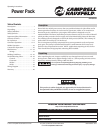
Operating Instructions
www.campbellhausfeld.com
4
◆ Never use an electric arc welder to thaw frozen pipes.
Flying sparks and hot metal can
cause injury. As welds cool, slag
can be thrown off. Take all precautions described in this
manual to reduce the possibility of injury from flying
sparks and hot metal.
◆ Wear ANSI compliant face shield or safety glasses with side
shield protection when chipping or grinding metal parts.
◆ Wear ear plugs when welding overhead to prevent spatter or
slag from falling into ears.
Electric arc welding operations
produce intense light and heat
and ultraviolet (UV) rays. This intense light and UV rays
can cause injury to eyes and skin. Take all precautions
described in this manual to reduce the possibility of injury
to eyes and skin.
◆ All persons operating this equipment or in the area while
equipment is in use must wear protective welding gear
including: welding helmet or shield with at least shade 10,
flame resistant clothing, leather welding gloves, and full foot
protection.
Never look at arc welding operations without
eye protection as described above. Never use a
shade filter lens that is cracked, broken, or rated below number 10.
Warn others in the area not to look at the arc.
Electric arc welding operations
cause sparks and heat metal to
temperatures that can cause severe burns! Use protective
gloves and clothing when performing any metal working
operation. Take all precautions described in this manual to
reduce the possibility of skin and clothing burns.
◆ Make sure that all persons in the welding area are protected
from heat, sparks, and ultraviolet rays. Use additional face
shields and flame resistant barriers as needed.
◆ Never touch work pieces until completely cooled.
Heat and sparks produced during
electric arc welding and other metal
working operations can ignite flammable and explosive
materials! Take all precautions described in this manual to
reduce the possibility of flames and explosions.
◆ Remove fire hazards from the welding area. If this is not
possible, cover them to prevent the welding sparks from
starting a fire. Welding sparks and hot materials from
welding can easily go through small cracks and openings to
adjacent areas. Avoid welding near hydraulic lines. Have a fire
extinguisher readily available.
◆ Take precautions to be sure that flying sparks and heat do not
cause flames in hidden areas, cracks, behind bulkheads, etc.
Fire and explosion hazard!
Do not weld on containers or pipes
that contained flammable / combustible materials or gases.
Arc welding closed cylinders or
containers such as tanks or drums
can cause explosion if not properly vented! Verify that
any cylinder or container to be welded has an adequate
ventilation hole, so that expanding gases can be released.
Do not breathe fumes that are
produced by the arc welding
operation. These fumes are dangerous. If the welding area
cannot be adequately ventilated, be sure to use an air-
supplied respirator.
◆ Keep your head out of the welding fumes.
◆ Do not perform electric arc welding operations on metals
that are galvanized or cadmium plated, or contain zinc,
mercury, or beryllium without completing the following
precautions:
a. Remove the coating from the base metal.
b. Make sure that the welding area is well ventilated.
c. Use an air-supplied respirator.
Extremely toxic fumes are created when these metals are heated.
The electromagnetic field that is
generated during arc welding may
interfere with the operation of various electrical and
electronic devices such as cardiac pacemakers. Persons
using such devices should consult with their physician
prior to performing any electric arc welding operations.
◆ Route the electrode and work cables together and secure with
tape when possible.
◆ Never wrap arc welder cables around the body.
◆ Always position the electrode and work leads so that they are
on the same side of the body.
◆ Exposure to electromagnetic fields during welding may have
other health effects which are not known.
Always be sure that the welding area is secure
and free of hazards (sparks, flames, glowing
metal or slag) prior to leaving. Be sure that the equipment is turned off
and electrode is removed. Be sure that cables are loosely coiled and out
of the way. Be sure that all metal and slag has cooled.
Important Safety Information (Continued)


















